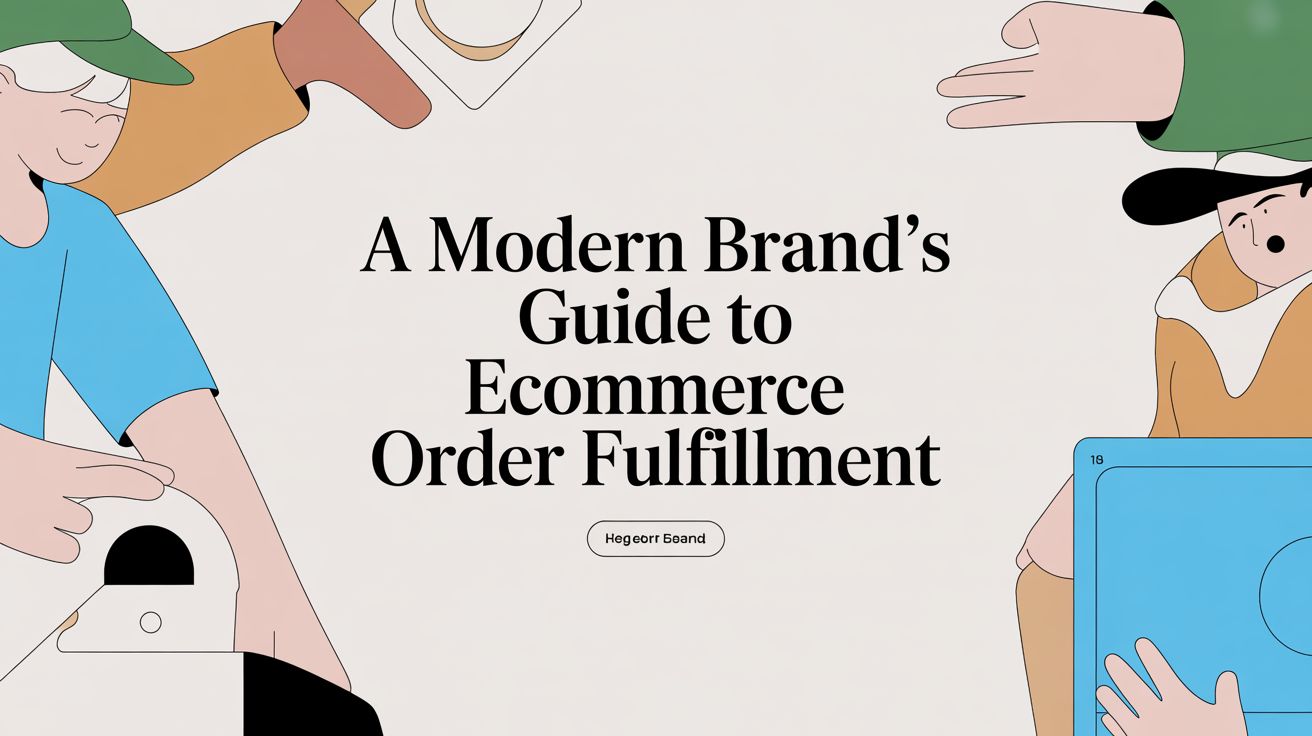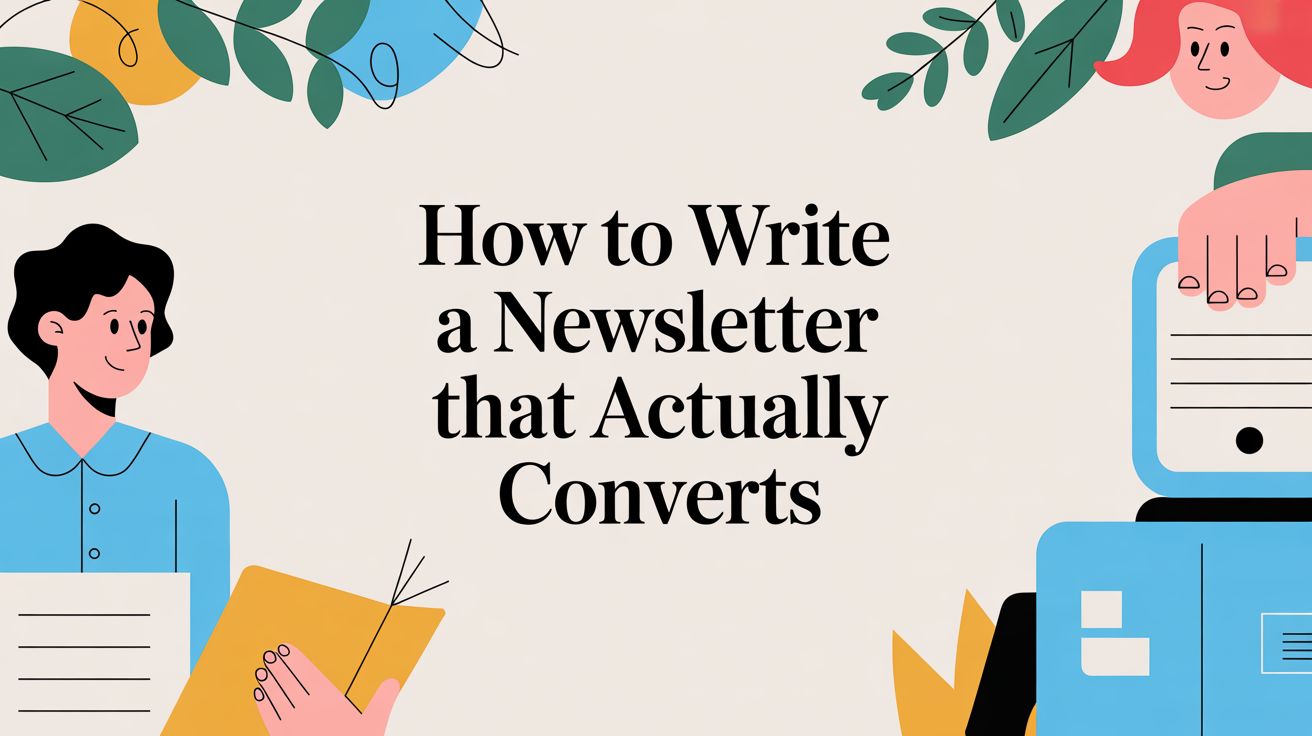
Choosing Your Ecommerce Marketing Platform: A Guide to Driving Revenue and Protecting Margins

An ecommerce marketing platform is the central nervous system for your brand's growth. It connects every customer touchpoint—email, SMS, on-site experiences—into one intelligent system designed to drive predictable revenue.
This isn't about slapping together a patchwork of disconnected apps. It’s about creating a unified, psychology-driven approach that unlocks operational efficiency, protects profit margins, and fosters sustainable growth.
What Is an Ecommerce Marketing Platform
An ecommerce marketing platform is a centralized software solution that integrates all marketing channels and customer data into a single, cohesive system. Its primary purpose is to enable brands to understand and act on customer behavior at scale, moving from fragmented campaigns to a unified, revenue-focused strategy.
This contrasts sharply with a disconnected tech stack where email, SMS, and on-site tools operate in silos, creating inconsistent customer experiences and operational drag. A true platform serves as the mission control for your entire brand, coordinating every marketing action based on a complete view of the customer.
The Shift from Disconnected Tools to a Unified System
For years, brands got by with a messy collection of separate apps. One for email, another for SMS, a third for loyalty, and maybe a basic pop-up tool for email capture. While each served a purpose, this fragmented setup created massive data silos.
The insights from your email campaigns never informed your SMS strategy. And neither of them connected to what a customer was actually seeing on your website. This leads to disjointed customer experiences and a ton of manual work for your team.
A unified platform solves this. It ensures every piece of customer data is shared across all your channels in real time, creating a seamless experience that boosts both conversions and operational efficiency.
A unified platform acts as a single source of truth for customer data. This eliminates information silos, enabling a cohesive and accurate view of every customer's journey from their first visit to their tenth purchase.
The Core Purpose of a Centralized Platform
So, what’s the real business impact? At its heart, an ecommerce marketing platform helps you understand and act on customer behavior at scale. By pulling all your data into one place, these systems empower your brand to:
- Automate Personalized Journeys: You can trigger specific messages based on real actions, like a customer abandoning their cart—an issue affecting nearly 70% of online shopping sessions.
- Segment Audiences with Precision: Go beyond simple demographics. Group customers based on complex behavioral data (e.g., browsing history, purchase frequency, predicted LTV) to create hyper-relevant campaigns that actually convert.
- Maintain Brand Consistency: Ensure your messaging, offers, and branding feel the same whether a customer interacts with you via email, text, or directly on your Shopify store.
- Improve Operational Efficiency: Stop wasting time manually managing a dozen different tools. Free up your team from exporting data and trying to connect the dots between campaigns so they can focus on high-impact strategy.
The rapid adoption of these platforms signals a major shift in how ecommerce works. The global e-commerce platform market was valued at USD 9.40 billion in 2024 and is projected to hit USD 45.60 billion by 2033. This incredible growth, detailed in a market analysis from Grand View Research, shows just how essential these integrated solutions have become for managing the complexities of online retail.
This visual shows how an ecommerce marketing platform serves as a central hub, integrating various marketing channels into a single, cohesive system.
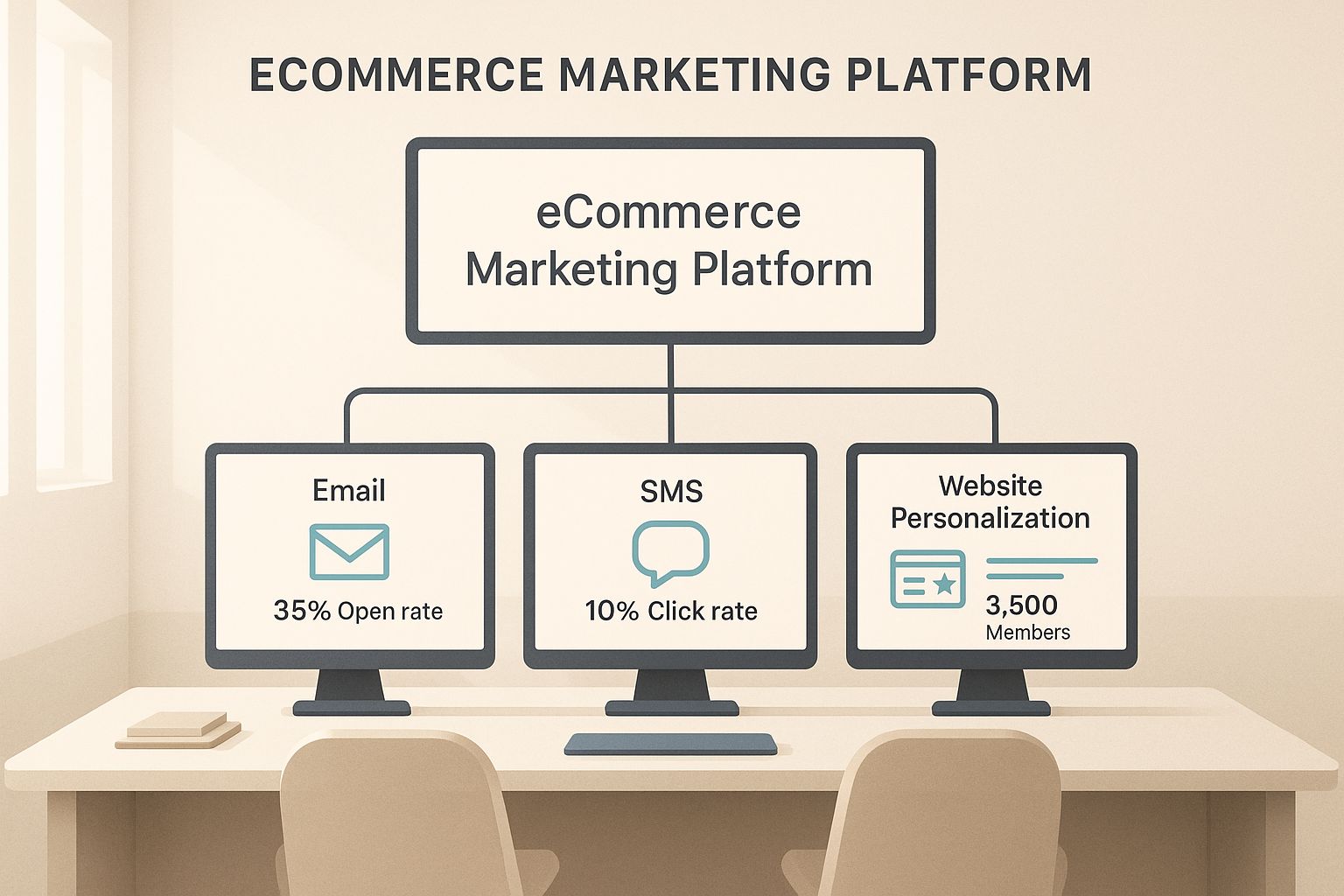
Ultimately, this integrated structure is what allows a business to move from reactive marketing to a proactive, data-informed strategy that drives predictable, repeatable growth.
Features That Protect Margins and Drive Revenue
Having a unified view of your customer is a great starting point, but a truly elite ecommerce marketing platform earns its stripes with specific features that directly impact your profitability. These aren’t just shiny bells and whistles; they’re strategic levers you can pull to increase Average Order Value (AOV), boost Lifetime Value (LTV), and—most importantly—protect your hard-won profit margins.
The most powerful features move past simple automation and dive into the science of why people buy. They help brands create genuine motivation, driving high-margin sales without falling back on the kind of margin-killing, site-wide discounts that just train customers to wait for the next big sale.
Advanced Segmentation with Behavioral Data
Basic segmentation might lump customers together based on their last purchase date. Advanced segmentation, on the other hand, goes way deeper. It uses real-time behavioral data to understand a customer's intent and anticipate their next move.
Think of it as the difference between sending a generic "We miss you!" email and a hyper-specific offer based on what that person actually cares about.
An effective platform should let you build dynamic segments that react to a mix of triggers:
- Browsing Behavior: Target customers who viewed a specific product category three times last week but never added to cart.
- Purchase History: Isolate shoppers who only ever buy from one collection and use that insight to introduce them to a new, complementary line.
- Engagement Patterns: Pinpoint customers who open every email but haven't clicked in 60 days, kicking off a unique re-engagement campaign.
- Predictive Analytics: Lean on the platform's own intelligence to flag customers who are about to churn or, conversely, those showing signs of becoming a VIP.
For Shopify Plus merchants, this is non-negotiable. You need a platform that integrates deeply with Shopify’s first-party data, pulling in customer tags, order history, and on-site actions to build surgically targeted audiences for campaigns across email, SMS, and even your website.
Psychology-Driven Urgency Marketing
This is where sophisticated platforms pull away from simple apps. Plenty of tools can slap a generic countdown timer on a product page—a tactic so overused that many shoppers have become numb to it. It often feels inauthentic and can damage brand perception.
Real urgency marketing is built on proven consumer psychology principles. Instead of just showing a clock, it creates a compelling event rooted in behavioral science.
Behavioral economics tells us that people are more motivated by the fear of missing out (FOMO) than by the promise of a good deal. A well-executed urgency campaign taps into loss aversion by framing an offer not just as a discount, but as a unique opportunity that's about to vanish.
Contrast a basic timer with the advanced, psychology-driven "Moments" orchestrated by Quikly. A basic timer is a static, one-size-fits-all gimmick. An advanced platform creates dynamic urgency based on real factors:
- Scarcity: Highlighting genuinely low stock levels on a product a specific customer keeps viewing.
- Anticipation: Building a groundswell of excitement for a limited-edition drop, turning a product launch into a can't-miss event.
- Social Proof: Showing how many other shoppers are looking at or have just bought a high-demand item, leveraging the principle of consensus to drive action.
This smarter approach drives immediate action without cheapening your products. It focuses squarely on generating revenue by creating genuine excitement, a world away from basic pop-ups designed only for email capture.
Omnichannel Automation That Adapts
Finally, a top-tier ecommerce marketing platform weaves these intelligent features into cohesive, automated workflows that follow the customer across every channel. This isn't just sending an email and then a text. It's about creating conversations that adapt in real-time based on what a customer does—or doesn't do.
An adaptive, revenue-focused workflow might look like this:
- A customer from a high-LTV segment abandons their cart.
- An hour later, an email lands with a reminder and a splash of social proof ("Over 50 people have bought this today!").
- If they don't open it after 24 hours, an SMS is automatically triggered via an integration with a platform like Postscript.
- If they return to the site but still hesitate, an on-site message offers a small incentive, like free shipping, to close the sale.
This kind of orchestration, seamlessly integrated with tools like Klaviyo for email and other SMS platforms, ensures you're delivering the perfect message on the right channel at the right time. And it all happens automatically, maximizing the revenue potential of every customer interaction.
The Strategic Impact of a Unified Platform
It’s easy to get lost in a list of features, but the real magic of an ecommerce marketing platform isn't about any single function. It’s about the cumulative power of having one system steer your entire marketing operation. This isn't just about convenience; it's about turning a tangled web of separate tools into an intelligent engine for growth.
The biggest win? You finally get a single source of truth for all your customer data. When your email tool, SMS provider, and pop-up app all live in separate worlds, you're left with a shattered picture of your customer. A unified platform stitches that picture back together, giving you a complete, 360-degree view of every shopper’s behavior and history.
Having that cohesive view is how you create the kind of consistent, relevant experiences that stand out and drive conversions above the industry average of 2.5%.
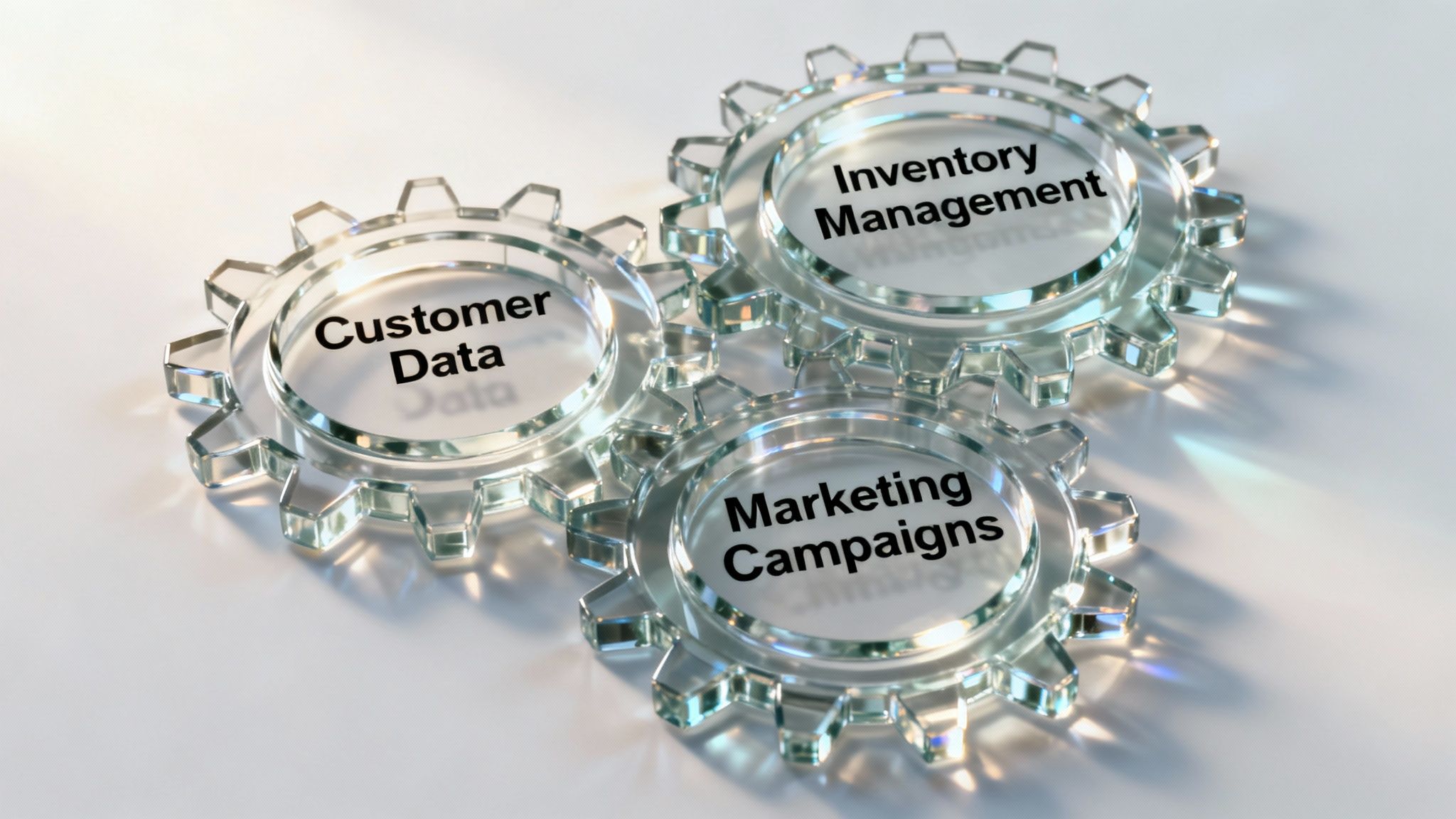
Boosting Efficiency and Reducing Costs
Juggling a dozen different marketing apps is an operational nightmare. Your team burns precious hours exporting and importing customer lists, trying to sync data, and attempting to make sense of performance reports from five different dashboards. A unified platform puts an end to that manual busywork, freeing up your people to focus on strategy and creative ideas instead of administrative headaches.
This consolidation hits your bottom line, too. Instead of paying for a patchwork of overlapping app subscriptions, you’re investing in one, more powerful solution. It simplifies your budget and often leads to significant cost savings.
Of course, a full marketing strategy can mix digital with physical. To get a sense of how brands handle the tangible side of things, it’s worth exploring different online printing services for marketing materials.
Smart Inventory Management That Protects Margins
Here’s one of the most powerful—and often overlooked—benefits of a unified system: it connects your marketing directly to your inventory. This creates an opportunity for incredibly strategic inventory management that protects your profit margins. It's a world away from running a panicked, site-wide fire sale.
Picture this: you have too much of a specific product. Instead of slashing the price for every visitor and cheapening your brand, a unified platform lets you be a surgeon.
You can pinpoint and segment the exact customers who have looked at that product before, or bought similar items. Then, you can launch a targeted urgency campaign just for them, giving this high-intent group a compelling reason to buy now.
This approach is brilliant because it accomplishes several things at once:
- It clears overstocked items without resorting to deep, margin-killing discounts.
- It protects your brand equity by avoiding the perception that your products are always on sale.
- It taps into consumer psychology by creating real scarcity and FOMO for a select audience, which drives faster sales.
This is the difference between reactive discounting and proactive, data-driven merchandising. It ensures your marketing doesn't just drive revenue but also contributes to healthy inventory turnover and strong profit margins. For a deeper dive into tracking the results of these kinds of promotions, check out our guide on how to measure marketing campaign effectiveness.
Choosing the Right Ecommerce Marketing Platform
Picking an ecommerce marketing platform is one of the most critical decisions a brand can make. This isn't just about grabbing a tool with the longest feature list. It's about finding a strategic partner that truly gets your business goals and marketing philosophy.
Get it right, and you'll accelerate growth and protect your margins. Get it wrong, and you're looking at operational headaches and wasted spend. A confident choice means looking past the flashy demos and doing a real, honest needs analysis.
First, a Comprehensive Needs Analysis
Before you even glance at a single platform, you have to map out what you actually need. A platform that's perfect for a scrappy DTC startup probably won't have the muscle a high-growth, omnichannel retailer requires.
Actionable Takeaway:
Start by asking these foundational questions:
- Where are we in our business journey? A brand new store might need solid lead capture and basic email automation. A scaling brand needs advanced segmentation and multi-channel workflows.
- What kind of technical resources do we have? Are you backed by a dev team that can tackle a complex setup? Or do you need a user-friendly platform your marketing team can run with on day one?
- What are our biggest goals right now? Is the focus on increasing AOV? Boosting customer retention? Or efficiently clearing aging inventory? Your goals separate must-have features from nice-to-haves.
Deep Integration is Non-Negotiable
A modern ecommerce marketing platform can't be an island. Its real power comes from how seamlessly it plugs into the rest of your tech stack. This is especially true for Shopify merchants, where first-party data is the fuel for every marketing play.
Put platforms that offer deep, native integrations at the top of your list.
- Shopify & Shopify Plus: The integration has to be more than a simple data sync. Look for the ability to pull in rich customer data, purchase history, and behavioral triggers straight from Shopify to power truly targeted campaigns.
- Email & SMS Providers: Make sure the platform plays nice with your go-to communication tools, like Klaviyo or Postscript. This is key for building out cohesive, automated messages that flow across different channels.
- Other Core Apps: Think about your loyalty programs, review apps, and help desk software. A platform that integrates well can pull data from these tools to make customer experiences even more personal and effective.
A platform's integration quality is a direct reflection of its strategic value. Shallow integrations create data silos and operational headaches, while deep integrations unlock a unified customer view that is essential for driving real ROI.
Scrutinize the Marketing Philosophy Behind the Tech
This is the step everyone misses, but it's the most important. You have to look past the feature list and understand the platform's core marketing philosophy. Does it lean on basic tactics like generic pop-ups and countdown timers? Or does it offer something more sophisticated, rooted in real consumer psychology?
Think about the difference between a simple pop-up app and an advanced urgency marketing platform like Quikly. A pop-up's main job is to grab an email, often by interrupting the user experience. Quikly, on the other hand, is built on proven principles of behavioral economics—like scarcity and social proof—to create genuine excitement that drives high-margin sales, not just sign-ups.
This difference is everything. A platform built on gimmicks will train your customers to wait for discounts, eroding your profit margins. A platform grounded in consumer psychology helps you build a brand that people are excited to buy from at full price. To get a better feel for the landscape, it's helpful to explore some of the best marketing automation tools and see how their core strategies differ.
To help you systematically evaluate your options, use this checklist to compare platforms side-by-side.
Platform Evaluation Checklist
| Evaluation Criteria | Key Questions to Ask | Why It Matters for ROI |
|---|---|---|
| Strategic Alignment | Does the platform's marketing approach match our brand's philosophy? Will it build long-term value or create short-term spikes? | A mismatched philosophy leads to discounting habits that erode margins. An aligned one builds brand equity and profitable customer relationships. |
| Integration Depth | How deep is the integration with Shopify? Does it sync real-time data for triggers? Does it connect with our key apps (email, SMS, loyalty)? | Deep integrations create a single source of truth, enabling hyper-personalized campaigns that convert better and drive higher LTV. |
| Ease of Use | Can our marketing team manage this platform without constant developer help? Is the interface intuitive for daily campaign management? | A difficult-to-use platform means slower campaign launches and higher operational costs, killing agility and ROI. |
| Scalability & Performance | Can this platform handle our peak traffic during major sales events like Black Friday? Does it have a proven track record with high-volume brands? | A platform that crashes under pressure means lost revenue and a damaged customer experience when it matters most. |
| Support & Partnership | What level of strategic support is offered? Do we get a dedicated success manager? Are they ecommerce experts who can offer real guidance? | Strong support isn't just about fixing bugs; it's about having a partner who helps you maximize the platform's value and hit your goals faster. |
This checklist forces you to move beyond feature-for-feature comparisons and focus on what will actually drive growth for your unique business.
Ultimately, choosing the right ecommerce marketing platform is about finding a solution that doesn't just meet your technical needs but also shares your vision for building lasting, profitable relationships with your customers.
Integrating Your Platform with the Shopify Ecosystem
For any merchant running their business on Shopify, a marketing platform that isn't deeply integrated is like an engine that isn't connected to the wheels. It might make plenty of noise, but it won't move your business forward.
Seamless integration is completely non-negotiable. It’s the crucial link that turns raw store data into profitable, automated marketing campaigns. A truly powerful ecommerce marketing platform has to do more than just sync a customer list; it needs to plug directly into the Shopify admin, tap into Shopify Plus APIs, and talk flawlessly with essential tools like Klaviyo and Postscript.
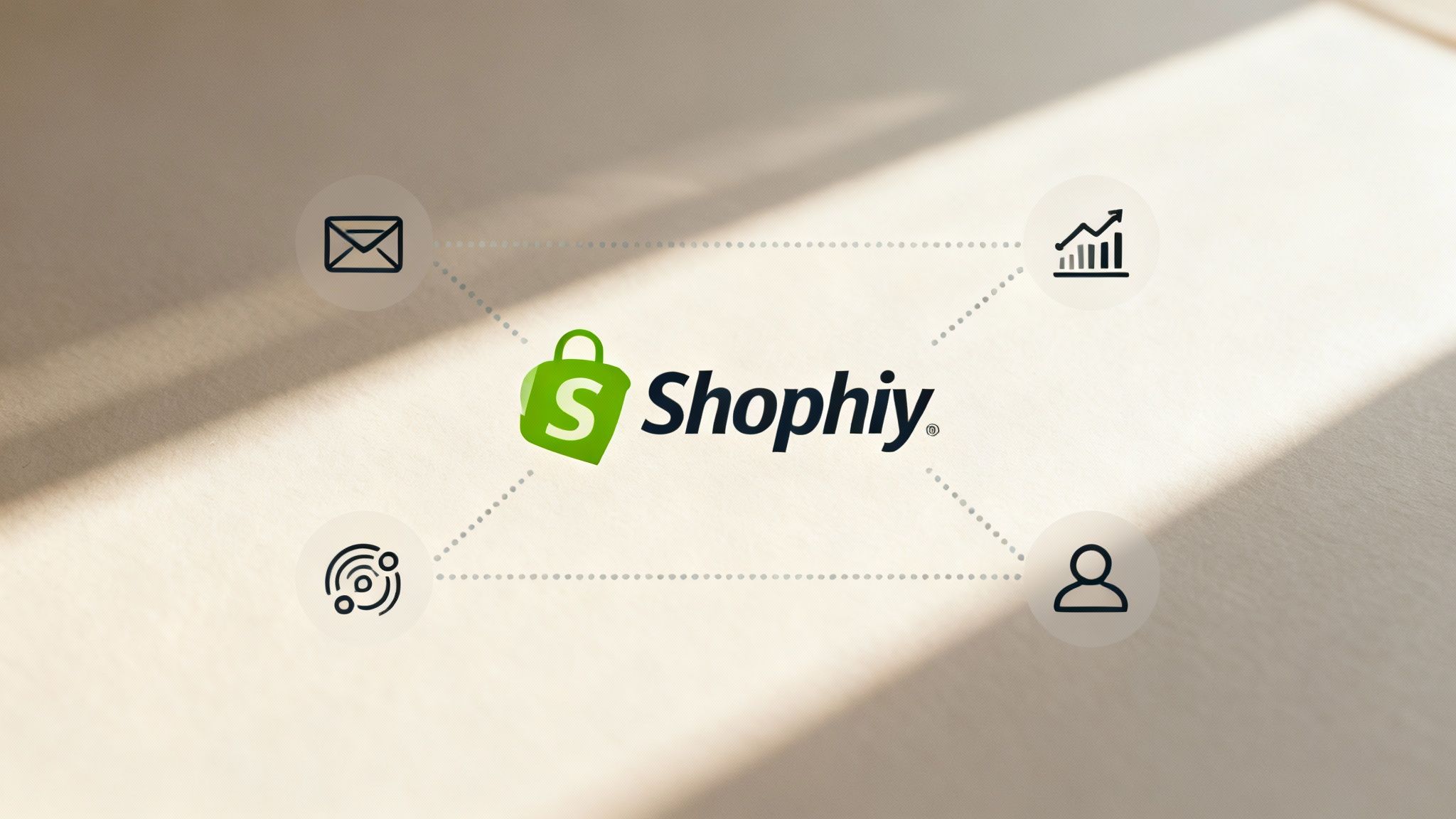
This deep connection is what lets a platform really dig into the rich, first-party data that Shopify holds. This includes more than just names and emails. True integration pulls in real-time behavioral data: what products a customer viewed, their entire purchase history, and even specific customer tags. This is the fuel for the kind of hyper-targeted segmentation that actually drives revenue.
Activating Shopify Data for Smarter Automation
Once your platform has this data, you can build sophisticated, automated workflows that feel personal and timely. Basic tools might send out a generic "come back" email, but a properly integrated platform can orchestrate entire customer journeys based on precise triggers in your Shopify store. This is where the real ROI of a connected tech stack becomes crystal clear.
Actionable Takeaway: Implement one of these Shopify-specific automations this week:
- Post-Purchase Upsell: A customer buys a specific coffee blend. Your platform sees this and immediately triggers a targeted email sequence two weeks later, offering a subscription for that same blend or suggesting a complementary product, like a high-margin coffee grinder.
- High-LTV Re-engagement: The platform spots a customer tagged as a "VIP" in Shopify who hasn't bought anything in 90 days. It automatically kicks off an SMS campaign with an exclusive offer, acknowledging their loyalty and giving them a compelling reason to come back.
- Inventory-Driven Urgency: Instead of a generic sale, your platform sees that a popular item is running low on stock. It can then create a dynamic segment of every user who has viewed that product and launch a targeted urgency campaign, using real scarcity to drive immediate, full-price sales.
A truly integrated platform doesn't just read data from Shopify; it acts on it. This ability to trigger automated, multi-channel campaigns based on real-time customer behavior is what separates a basic app from a revenue-generating growth engine.
Building Your Shopify-Centric Tech Stack
The Shopify ecosystem is massive, with 4.6 million active websites globally as of 2024. This huge market share, especially in the U.S., has fostered a rich environment of specialized apps. (You can read more about the current e-commerce platform market share on SQ Magazine to get a sense of the scale.) Your ecommerce marketing platform needs to be the central hub, coordinating the actions of all these other tools.
The goal is to create a system where every piece of your stack shares intelligence. The campaigns your marketing platform runs should be informed by data from your loyalty app, and the segments you build should be easily pushed to your email and SMS providers. This level of connectivity ensures a consistent customer experience and maximizes the value of every single tool you invest in.
For more ideas on building out your toolkit, check out our guide on the best Shopify marketing apps to see how different solutions can work together.
Common Questions About Ecommerce Marketing Platforms
Digging into ecommerce tech always brings up a few questions. Getting clear, straightforward answers about the tools you’re looking at is the only way to make a decision you feel good about. So, let's tackle some of the most common things people ask when choosing an ecommerce marketing platform.
Platform vs. CRM: What’s the Difference?
This is a big one. While both an ecommerce marketing platform and a Customer Relationship Management (CRM) system deal with customer data, they’re built for totally different jobs. A traditional CRM is usually designed for sales teams managing one-on-one relationships and long sales cycles, which is why you see them a lot in B2B.
An ecommerce marketing platform, on the other hand, is built specifically for the high-volume, fast-paced nature of online retail. Its whole purpose is to automate marketing campaigns and group customers based on actual shopping behaviors—like what they bought, what they browsed, and their lifetime value. A great platform will have CRM-like features, but it's fine-tuned for the scale and pace of ecommerce.
How Much Should I Expect to Pay?
The price tag on these platforms can be all over the map. It really depends on the size of your contact list, how many messages you’re sending, and how powerful the features are. For a brand that's just starting out, you might find simple platforms for around $50 per month.
But for growing brands that need more firepower—we’re talking sophisticated automation, psychology-driven urgency, and campaigns that run across multiple channels—the cost can range from several hundred to thousands of dollars a month. The real trick is to stop looking at the cost and start looking at the return. A platform that costs more but genuinely drives up customer lifetime value and revenue is a much better investment in the long run.
How Hard Is It to Switch Platforms?
Moving from one platform to another requires a solid plan, but it’s something most brands can handle. The process usually involves migrating your customer data, rebuilding your key customer segments, and setting up your essential automations and campaign templates all over again.
To make the switch less painful, look for a new platform that offers dedicated help with onboarding and migration. But the best strategy is to pick a platform from the get-go that can grow with you. Choosing a solution that supports your business from day one saves you a massive amount of time, effort, and money down the road, freeing you up to focus on what really matters: building your brand.
Ready to transform your marketing from basic tactics to a revenue-generating machine? With Quikly, you can harness the power of consumer psychology to drive high-margin sales and build genuine customer excitement. See how our urgency marketing science can grow your brand.

The Quikly Content Team brings together urgency marketing experts, consumer psychologists, and data analysts who've helped power promotional campaigns since 2012. Drawing from our platform's 70M+ consumer interactions and thousands of successful campaigns, we share evidence-based insights that help brands create promotions that convert.
